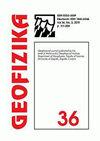Analysis of gravity disturbance for boundary structures in the Aegean Sea and Western Anatolia
IF 1.1
4区 地球科学
Q4 GEOCHEMISTRY & GEOPHYSICS
引用次数: 4
Abstract
Western Anatolia has been shaped N–S-trending extensional tectonic regime and W-E trending horst, grabens and active faults due to the collision of Africa, Arabian and Eurasia plates. The borders of the Aegean Sea tectonic is limited between eastern of Greece, western of Anatolia and Hellenic subduction zone in the south of Crete. To evaluate these tectonic elements gravity disturbance data of the Aegean Sea and Western Anatolia was used in this study. It is thought that the gravity disturbance data reflects the tectonic elements and discontinuities way better than gravity anomaly due to the calculation from the difference between gravity and normal gravity at the same point so thus the tensors and invariants of the study area were calculated and the power spectrum method was applied to the gravity disturbance data. Various boundary analysis methods were applied to the gravity disturbance data to compare the discontinuities obtained from the tensors both theoretical and case study. These methods were tested initially on theoretical data. Within the scope of the theoretical study, a single model and three bodies model were taken into consideration. When the results are examined, it is observed that the Tzz tensor component gives very clear information about the location of the structure. Likewise, when the Txx, Tyy components and invariant results are examined, the vertical and horizontal boundaries were successfully obtained. In addition, the mean depths of these structures were determined using the power spectrum method. In the case application stage, the gravity disturbance data obtained from the Earth Gravitational Model of the eastern of the Aegean Sea and western of Anatolia were evaluated. The tensor and invariants of this gravity disturbance data were first calculated. New possible discontinuities have been identified in the tensors and some of the obtained discontinuities were clarified in their previous discussions. Also, the mean depths of the possible structures were calculated by the power spectrum method at four profiles taken from gravity disturbance data. These depth values are consistent with the depth values of the structural discontinuities obtained from previous studies. Finally, the upward continuation was applied to Tyy, Tyz and Tzz tensors up to 20 km. The positive anomaly values in Tyz and Tzz components and negative anomaly values in Tyy component are consistent with the Western Anatolia Transfer Zone. The structural differences between the eastern and the western of Western Anatolia are noteworthy in the upward continued results of the tensors. In addition, the positive and negative anomalies are notable in areas where the big earthquakes occurred in the last 3 years in the Tyz invariants.爱琴海和西安纳托利亚边界结构的重力扰动分析
在非洲、阿拉伯和欧亚板块的碰撞作用下,安纳托利亚西部形成了南北向的伸展构造体系和东西向的地体、地堑和活动断裂。爱琴海构造边界局限于希腊东部、安纳托利亚西部和克里特岛南部的希腊俯冲带之间。为了评价这些构造要素,本文利用了爱琴海和西安纳托利亚的重力扰动资料。考虑到重力扰动资料是根据同点重力与正常重力之差计算的,因此比重力异常更能反映构造要素和不连续面,因此计算了研究区的张量和不变量,并将功率谱法应用于重力扰动资料。采用不同的边界分析方法对重力扰动数据进行了理论分析和实例分析,比较了由张量得到的不连续点。这些方法最初是在理论数据上进行检验的。在理论研究范围内,考虑了单体模型和三体模型。当检查结果时,可以观察到Tzz张量分量给出了关于结构位置的非常清晰的信息。同样,当检查Txx, Tyy分量和不变结果时,成功地获得了垂直和水平边界。此外,利用功率谱法确定了这些结构的平均深度。在实例应用阶段,对地球引力模型在爱琴海东部和安纳托利亚西部获得的重力扰动数据进行了评价。首先计算了重力扰动数据的张量和不变量。在张量中发现了新的可能的不连续点,并在之前的讨论中澄清了一些得到的不连续点。在重力扰动数据的四个剖面上,用功率谱法计算了可能结构的平均深度。这些深度值与以往研究得到的构造不连续面深度值一致。最后,对Tyy、Tyz、Tzz张量向上延拓至20km处。Tyz和Tzz分量的正异常值和Tyy分量的负异常值与西安纳托利亚转移带一致。西安纳托利亚东部和西部的结构差异在张量的向上延续结果中值得注意。此外,Tyz不变量中近3年发生大地震的地区正、负异常显著。
本文章由计算机程序翻译,如有差异,请以英文原文为准。
求助全文
约1分钟内获得全文
求助全文
来源期刊

Geofizika
地学-地球化学与地球物理
CiteScore
1.60
自引率
0.00%
发文量
17
审稿时长
>12 weeks
期刊介绍:
The Geofizika journal succeeds the Papers series (Radovi), which has been published since 1923 at the Geophysical Institute in Zagreb (current the Department of Geophysics, Faculty of Science, University of Zagreb).
Geofizika publishes contributions dealing with physics of the atmosphere, the sea and the Earth''s interior.
 求助内容:
求助内容: 应助结果提醒方式:
应助结果提醒方式:


